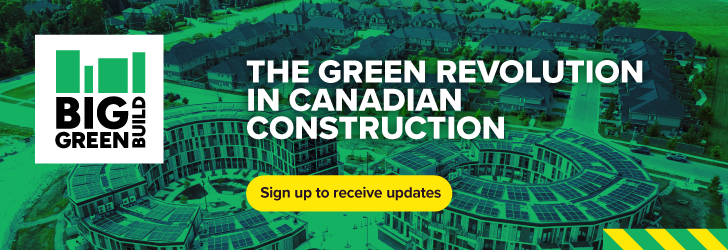
“Never let a good crisis go to waste.”
It’s a business adage that could have been coined for the challenge of transforming Canada’s carbon-intensive construction and buildings sector in time to meet the country’s ambitious — and increasingly imperiled — climate action goals.
Ottawa has spent over two years fine-tuning its Canada Green Buildings Strategy, a masterplan to slash greenhouse gas (GHG) emissions from the “built environment” — the 16 million homes and nearly 500,000 buildings where people live and work — to reach net zero in the sector by 2050.
It's a huge task for the country’s third heaviest polluting industry after oil and gas and transportation, once emissions from building heating and cooling systems powered by fossil fuels are factored in.

Add “embodied carbon” — the CO2 emitted when manufacturing the materials used in construction, chiefly concrete and steel — and the sector accounts for nearly 30 per cent of Canada’s carbon emissions.
“The industry has been slow to change,” green buildings advocate Thomas Mueller told Canada’s National Observer.
“Policy and investment decisions taken now will impact new builds and retrofits that will decide Canada’s carbon footprint for decades to come,” said the CEO of the Canada Green Building Council (CAGBC), an industry advocacy group.
Canada’s future competitiveness in the buildings sector will hinge on new low-carbon technologies, green jobs and skills sets, and a clean electricity grid, said Bruce Blackie, a spokesman for Natural Resources Canada, which developed the Green Buildings Strategy.
“There is no meeting our climate targets without major shifts to both our approach to new builds and retrofitting existing buildings,” he said.
But the government’s soon-to-be-published action plan comes at a tumultuous time in Canada’s energy transition.
The strategy’s main objective — a 37 per cent cut in direct emissions from commercial, residential and institutional building from 2005 levels by the end of the decade — faces formidable hurdles.
One is the Liberal government’s pledge to “mobilize” the construction of nearly 4 million new homes by 2031 — Canada’s biggest housing construction campaign since after the Second World War.
Rather than cutting CO2 emissions, building fast with high-carbon materials and heavy-emitting construction methods would drive GHG levels higher as Canada’s Paris Agreement climate commitment deadlines draw closer.
At the same time, retrofitting millions of homes, office towers and public buildings — by installing energy efficiency-boosting, high-spec glass and ventilation, replacing fossil gas furnaces with heat pumps, and adding solar or geothermal power — will cost tens of billions of dollars a year.
Then there’s the challenge of greening the construction industry itself.
Many industry players say erecting millions of new buildings of all architectures on a very short timeline, while adopting more environmentally sustainable designs, materials and construction techniques, could be an impossible request.
 Big Green Build by the numbers
Big Green Build by the numbers
new homes Ottawa aims to “unlock” by 2031. Building in a smart, climate-aligned way could save 66.5 million tonnes of climate pollution versus business as usual.
total new homes needed by 2030, Canada’s housing agency said in 2022. Building better could save 100 million tonnes of climate pollution.
share of Canada’s 16 million existing homes heated by fossil fuels such as natural gas. It's 80 per cent for 482,000 commercial/public buildings.
current annual rate of building retrofits depending on the structure. It would take 71 years to retrofit all commercial buildings and 142 years for low-rise homes at current rates.
annual retrofit “cruising speed” needed to decarbonize most residential and commercial buildings by 2040.
low range cost per square metre to retrofit most commercial and public building types. High-cost ranges from $400-$500 sq m.
cost range for shell upgrades, heat recovery ventilation system and heat pump for a single-detached home. $33,000-$43,000 for an apartment unit.
number of tradespeople, engineers, architects and others working in green construction. A major transition will need 45 per cent more HVAC workers and 55 per cent more electricians.
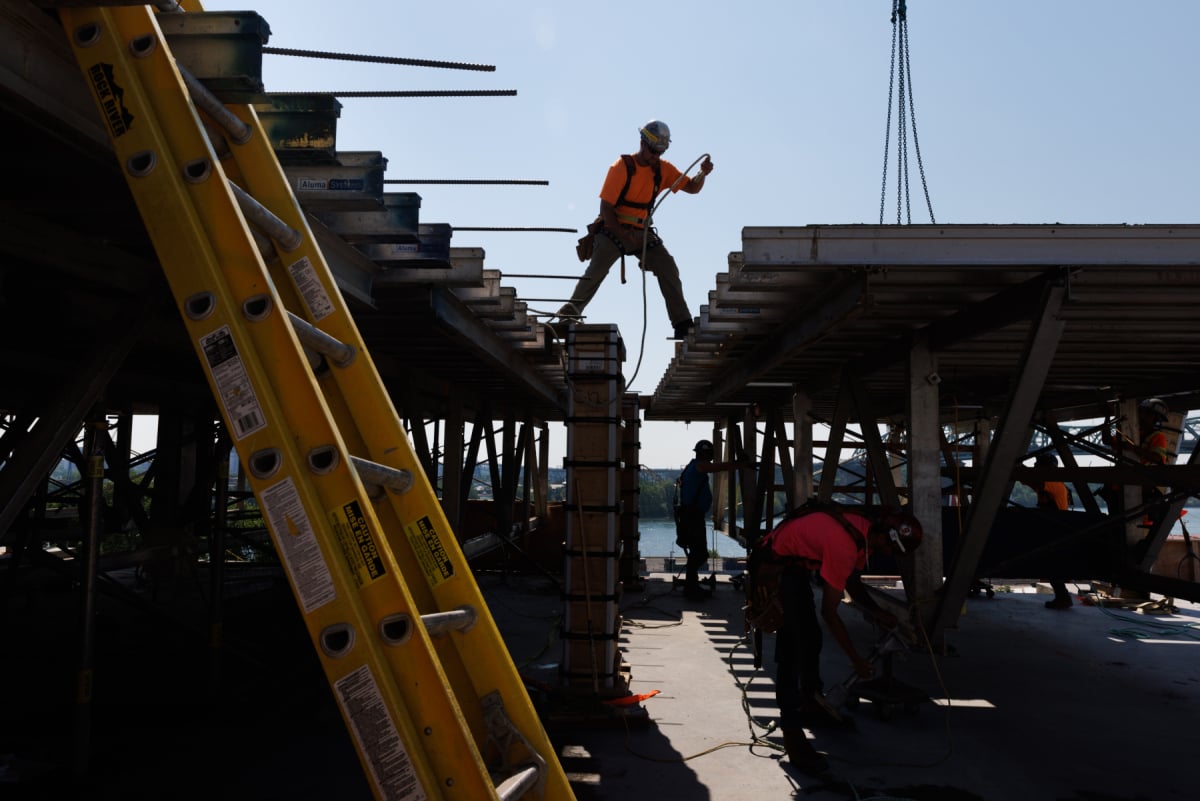
Decarbonize at “massive scale”
Get the strategy right, however, and Ottawa could translate these many challenges into market-making opportunities, creating a huge potential win-win in the coming building bonanza.

The first win is economic. A fast-track shift to zero-carbon building designs backed by stringent green building codes and decarbonization mandates could inject $150 billion into Canada’s economy by 2030 and create up to 1.5 million jobs, according to the CAGBC.
The second is environmental. Sharply reducing CO2 emissions from buildings to reach Ottawa’s 2030 target of 53 million tonnes — equal to taking 11 million cars off the roads — would not only cut pollution, but also keep Canada’s 2050 goal of a net-zero building sector within reach.
The building sector needs to decarbonize at a massive scale.
Thomas Mueller, Canada Green Building Council
These goals may be “aspirational,” Mueller said, but they are a clear signal to the marketplace: “The building sector needs to decarbonize at a massive scale.”
A CAGBC report concluded that new zero-carbon buildings “of all architectures” from commercial skyscrapers and government offices to schools and family homes are “technically and financially viable” today.
But a revolution in green building will not be enough, according to the Ottawa-based group. At least 150,000 existing large buildings — about one-third of building stock from coast to coast — must be retrofitted and decarbonized to meet Canada’s climate action targets, Mueller said.
“That is a huge business opportunity too, if you can get the return on investment needed, plus the generation of economic growth,” he said.
Even low-carbon construction advocates agree that Canada’s $151 billion building industry – just over 7 per cent of the economy and employing 1.6 million people – is a juggernaut that will be hard to steer in a new, greener direction.

“Construction and real estate hasn't innovated, in my opinion, in 100 years,” said Natalie Voland, a sustainable real estate developer in Montreal.
Her company, GI Quo Vadis, which specializes in retrofitting historic buildings, secured funding in 2022 for a net-zero renovation of derelict industrial warehouses on the city’s Lachine Canal into a complex offering affordable rents to green businesses and entrepreneurs.
Construction and real estate hasn’t innovated, in my opinion, in 100 years
Natalie Voland, GI Quo Vadis
The project, now entering final engineering before reconstruction work begins, will include extensive efficiency upgrades to heating, ventilation and cooling systems, and a renewable power system, possibly employing geothermal energy.
Voland believes the tide is finally turning for the decarbonization of the building sector. But distinct government policies and incentive programs are needed for both green retrofitters and sustainable new build developers to lay the cornerstone of a future zero-carbon construction sector. “These are two different planets that need two different solutions,” she said.

EV ecoburb: “a different way of living”
An innovative greenfield developer is building one of those “different solutions” - a solar-powered EV ecoburb.
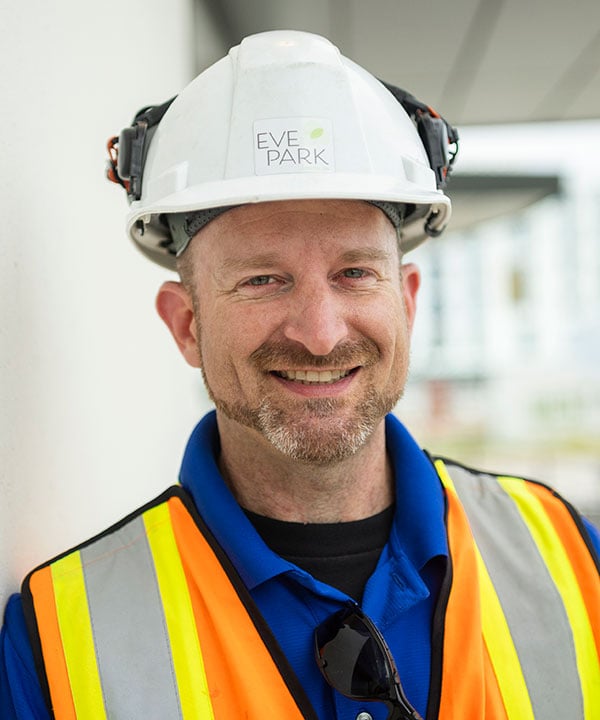
The Electric Vehicle Enclave (EVE) Park is being built in London, Ont. by developer s2e Technologies and international architecture firm Gensler.
The project — supported by Built Green Canada, an industry-led group that works with the building sector to advance sustainable practices — aims to offer “a different way of living,” said s2e Vice President of Technology Derek Satnik.
EVE is an all-electric, net-zero community, with solar rooftop arrays powering a micro-grid wired into energy-efficient condominiums. It also features vertical parking towers and charging stations for a fleet of electric vehicles.
Let’s make our homes exceptionally efficient and able to power themselves
Derek Satnik, s2e Technologies
“We need to move around, so let’s use EVs and car-sharing to do that well. And we need shelter, so let’s make our homes exceptionally efficient and able to power themselves,” Satnik said.
The first phase of EVE is complete, with owners moving in late last year, he said, adding the “living experiment” is starting to show how ecoburbs can be part of future climate solutions in the residential sector.
“Housing is a complicated topic right now, balancing the availability of trades with affordability and the need for more sustainable construction practices. It’s not easy, or more builders would do it,” Satnik said.
Progressive projects like EVE are a model for other developers, said Built Green CEO Jenifer Christenson, but it's “not that straightforward.”
The burden of the green transition will fall on builders and developers who face competing government priorities to build fast, affordable and sustainable projects while also cutting GHG emissions, she said.
Add to that a tough operating environment of tight margins, rising costs, an acute shortage of tradespeople and technicians, and home buyers balking at potentially higher green home prices.
“Creativity is paramount as industry looks for new ways of doing things and assesses their effectiveness,” Christenson said.
 GHG emissions in construction and buildings
GHG emissions in construction and buildings


Focus on large buildings first
Government plans for millions of “climate friendly” homes may dominate news headlines, but only big low-carbon buildings, new or retrofitted, will put meaningful downward pressure on Canada’s emissions levels.

“To meet 2030 targets, we need to focus our attention on large buildings,” said Hugo Lafrance, Director of Sustainability at Montreal’s Lemay Architects, which retrofitted a 1950s-era warehouse for the firm’s zero-carbon headquarters, dubbed the Phénix.
To meet 2030 targets, we need to focus our attention on large buildings.
Hugo Lafrance, Lemay Architects
Big building retrofits — from electrifying heating and cooling systems by integrating renewable energy sources such as rooftop solar panels, to replacing windows, doors and walls to make the building “envelope” ultra energy efficient — could cut emissions by up to 51 per cent, according to the CAGBC.
“This is where the real energy intensity is. The pressure should not be placed on citizens owning single-family homes,” Lafrance said. “It must be on the large commercial and institutional building owners and developers, where we can have the greatest gains in the near-term, not just in terms of emissions reductions, but also economic development.”

Ottawa knows it too. Net-zero, climate resilient commercial, residential and institutional buildings would together improve energy affordability, reduce extreme weather impacts and support “increasing economic activity, increasing jobs, and increasing money in Canadians' pockets,” a 2022 Green Buildings Strategy discussion paper said.
The cost of constructing green new builds could be passed on to buyers and renters, but who will foot the bill for high-priced and often necessarily bespoke retrofits of existing buildings?
Efficiency Canada, an Ottawa-based think tank, estimated in 2021 that retrofitting the country’s building stock could cost $20-$60 billion a year depending on the time frame. Calgary-based Pembina Institute says a 20-year “renovation wave” would need public investments closer to $10-15 billion a year.
The 2024 federal budget earmarked over $900 million to roll out the Canada Green Buildings Strategy, the bulk of it going to support energy-efficient retrofits to cut home energy bills. There was scant mention of funds for extensive commercial retrofits.
The Canada Infrastructure Bank’s existing $2 billion program offers low-cost finance to underwrite retrofits, but larger-scale subsidies or stricter green building codes and regulations would have more impact, a Royal Bank of Canada report said last year.

Developer Malcolm Shield, speaking at a retrofitting conference last month, pointed to the imbalance seen in the billions of government dollars in subsidies and tax breaks channeled into plans to expand Canada's EV supply chain ecosystem.
“Where's the support for retrofits in Canada? Where's the support for commercial real estate?” said Shield, Vice President of Sustainability for Vancouver-based Wesgroup Properties.
Direct financial support for the industry’s transition was viewed as “unpalatable and distasteful,” he added, despite the sector’s central role in the housing, affordability and climate crises playing out today.
“We need to understand this is our total benefit and how tax dollars can be better used to provide future infrastructure, future housing, appropriate industrial space,” he said.
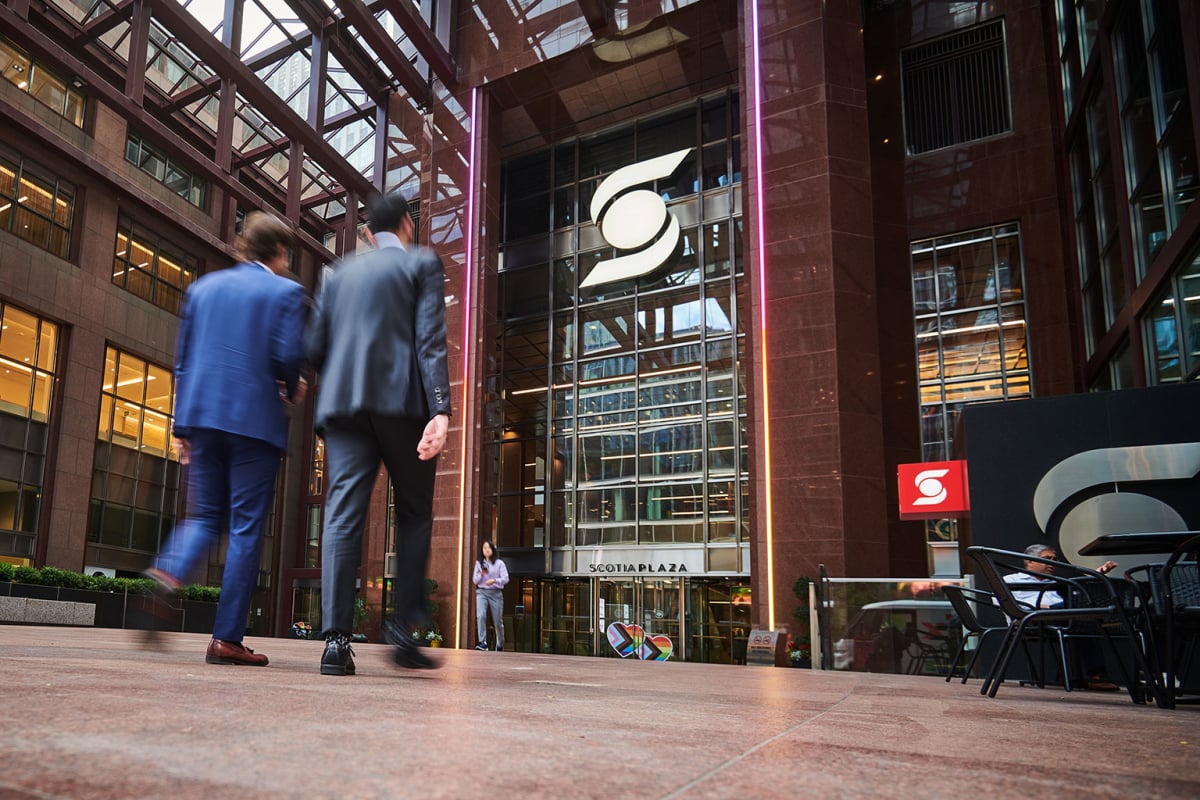
Canada’s biggest zero-carbon building
The cost-versus-carbon conundrum weighed on real estate investment giant KingSett Capital in 2019 when it pitched a plan to investors to cut emissions at the power-hungry Scotia Plaza office-tower complex in Toronto.

Today, the 68-storey Scotiabank headquarters at 40 King St. is Canada’s biggest zero-carbon certified building and paved the way for green retrofits of sister towers at 44 King St and 100 Yonge St.
Launching the first project required broader thinking “to keep the long-term value of decarbonization in focus,” said Kit Milnes, Vice President of Sustainability and Resilience at KingSett.
“We have been focused on sustainability at KingSett for over ten years but, that said, there wasn’t a lot of focus on carbon as the selling point to pursue green building certification,” he said.
“In 2014, if I had gone to our investors and said: ‘Let’s put in heat pump plants in all our buildings and rotate out all the natural gas in favour of electric systems,’ I simply would not have gotten the buy-in for that kind of ‘green premium.’”
What’s good in a building is good in a portfolio” for sustainability and ESG
Kit Milnes, KingSett Capital
It was an easier sell to propose a “one-to-three year payback” on energy efficiency measures in the Scotiabank headquarters that were low-cost and promised substantial savings in the long-term, Milnes said.
“This philosophy is what we are embracing, as ‘carbon emissions’ become the thing all industries, including real estate, really should have been focusing on all along,” he said. “Even if the payback is going to be more like five-to-ten years.”
KingSett aims to cut carbon emissions by 35 per cent across its asset portfolio by 2027, more than doubling its decarbonized square footage to 6.3 million-square-feet.
“What’s good in a building is good in a portfolio and can be the start of how you build a programme for sustainability and ESG,” Milnes said, referring to an investment strategy that assesses companies on their environmental, social and governance risk factors.
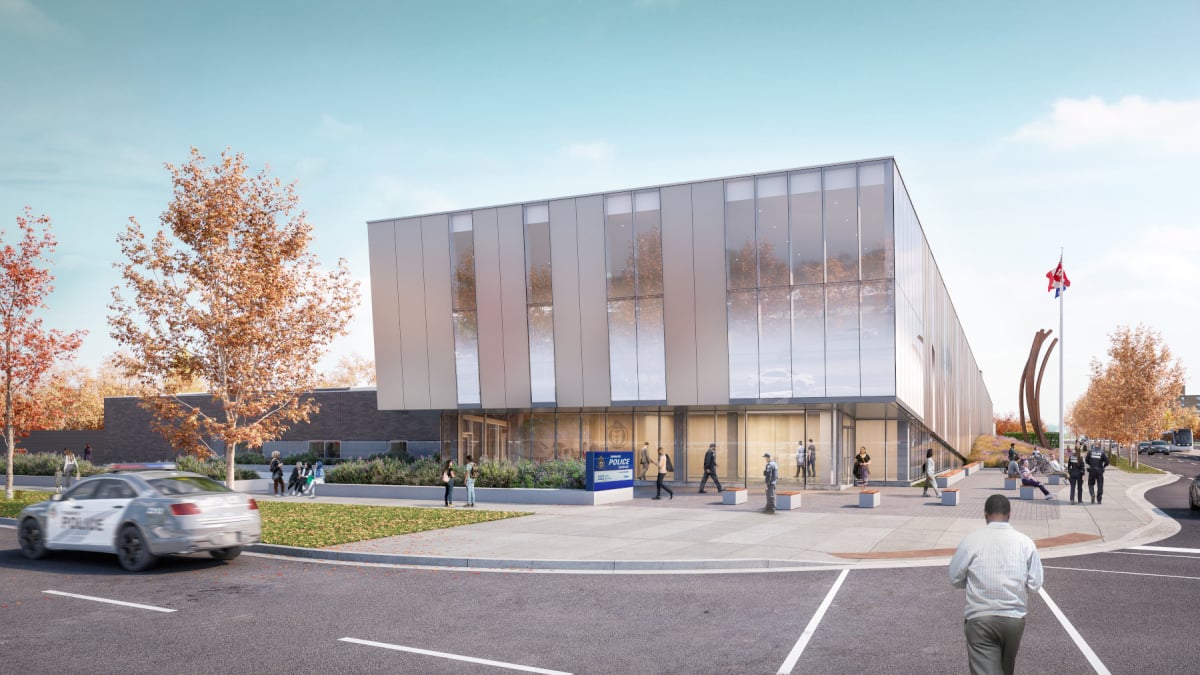
Climate-friendly “cop shop”

In Toronto, plans for a new police station in Scarborough show how clean-sheet green construction could accelerate the transformation of a cityscape.
The brainchild of WZMH Architects, best known for Toronto’s iconic CN Tower, the new 60,000-square-foot office and detention centre will be the first city building to be badged net-zero when it opens in 2026.
The new Division 41 station will feature an underground geothermal energy plant to power heating and cooling equipment, high-efficiency lighting, triple glazed windows, an energy recovery ventilation system, and a climate-resilient, bio-diverse ‘green roof’ fitted with solar panels.
The result is a facility that will be 70 per cent lower carbon than past designs, said Nicola Casciato, a principal at WZMH.
The net-zero station, he said, "is a model for next-generation low-carbon architecture and how [to] collaborate on progressive projects."
“The banker, builder, architect and future building operator were in the same room from the first day,” Casciato said.
“Design, materials, life cycle costs, maintenance — those are all in the conversation from day one. We all want to be sure all money is well spent, as well as being good for the environment.”
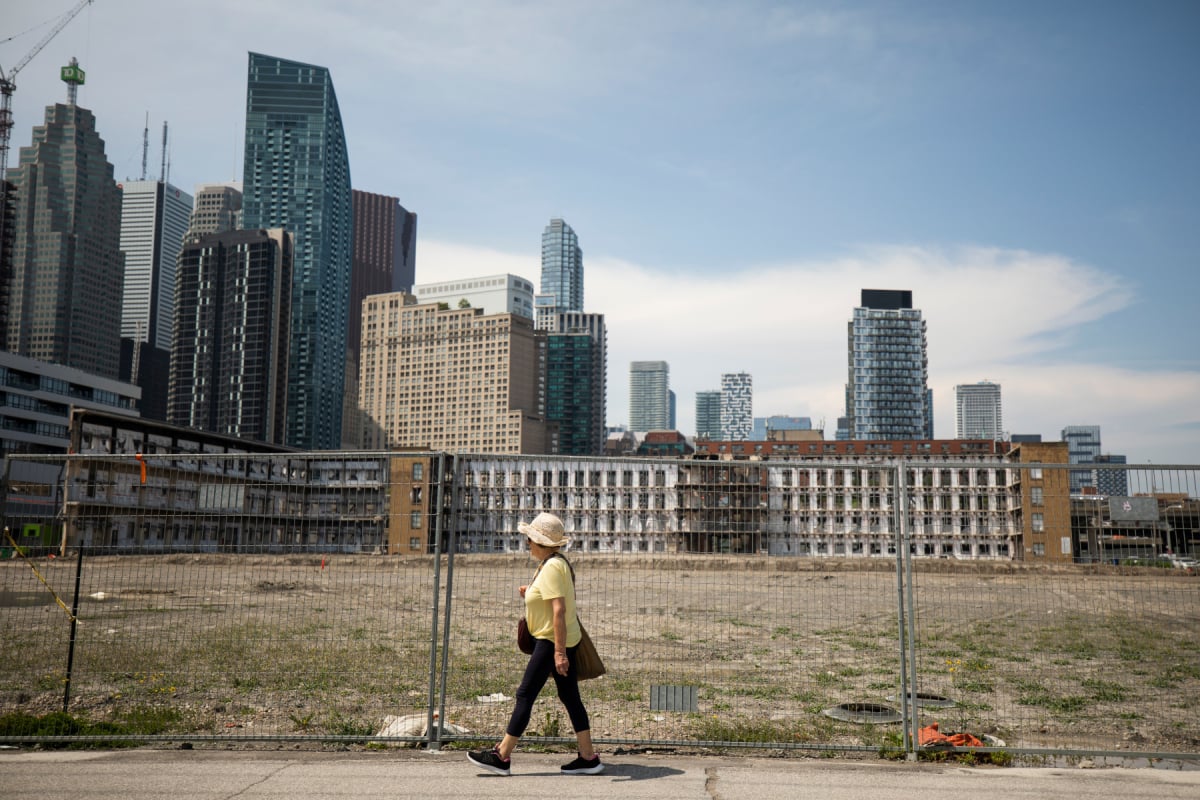
Pay now or pay later
Green building advocates argue that governments at the federal, provincial and municipal levels will have to step up with funding, fit-for-purpose regulations and progressive policy mandates to drive the construction sector’s transition as fast as needed.
The Pembina Institute has an action plan for deep retrofits of 32 million square metres of existing commercial space and 600,000 homes a year to help meet 2050 emissions targets. It calls for zero-carbon construction mandates, updated building codes and standards, and incentives to rapidly expand the green workforce and clear supply chain bottlenecks.
Governments can provide market certainty for greener construction “by implementing regulations that require deep building decarbonization,” said Jessica McIlroy, manager of Pembina's buildings programme.
At the same time, she added, utilities and governments should boost grants and incentives to help pay for the innovative, low-carbon technologies needed for deep retrofits.
Pay now, or pay later. It’s another business maxim that sums up the hard choices for governments, industry, businesses — and even private homeowners — as the climate crisis intensifies.
“The problem is — whether it is a new building or a retrofit — if we don't invest in that building, to get as close to zero-carbon as possible, then we’ll need to make that retrofit later on as carbon mitigation or climate resiliency, and it’s going to be far more expensive,” Mueller said.
“We cannot keep shifting the transition into the future.”
Green Building Strategy at a glance
- Build net-zero: new structures are built net-zero carbon ready by 2027 and no later than 2032; meet climate-resilient codes and standards by 2025 and no later than 2030.
- Rapid retrofits: boost annual retrofit rate to 3-5 per cent by 2025, with financial incentives and public funding to reduce investment risk.
- Transform heating: set phased timelines to electrify space and water-heating equipment such as high-emitting oil and natural gas furnaces. Ensure rapid uptake by offering incentives for heat pumps.
- Materials and methods: open a new research hub to identify low-carbon building materials and processes that can be scaled up by 2030. Launch buy clean strategy to promote made-in-Canada low carbon products.
- Clean jobs: develop regional workforce plans to identify gaps and skills needs; open a Clean Jobs Training Centre to prepare workers for a zero-carbon construction industry.
- Codes and standards: set a new performance-based national building code to promote low-carbon building materials like mass timber, low-carbon steel and concrete. Develop model codes by 2025 that address energy efficiency and operational carbon emissions.
- Decarb demo: governments show the way. New public buildings are built net-zero carbon ready and meet climate resilience codes by 2025. Deep retrofits of existing public buildings should deliver at least 50 per cent energy savings and cut emissions by at least 80 per cent.
From building new net-zero office buildings and homes to green retrofitting the rest, a new generation of developers are changing the way Canada thinks about its built environment. In the second story in our Big Green Build series, CNO shines a spotlight on five pioneers showing how the industry can embrace a low-carbon future. Get the next story delivered to your inbox.



Comments
About 4-5 years ago, we bought what was labelled a NET Zero like home, but realistically, it is not a true NET Zero home, more of a very energy efficient home (certified as such). We could have added the solar panels on the roof as an option, but the cost was crazy to do at the time. Where it falls short as well, is that the furnace uses natural gas, but despite that, is extremely energy efficient, and instead of the traditional hot water tank, we had a hybrid tankless water heater put in. For the latter, at least we are not heating a tank water heater constantly 24/7 with gas.
But because of the way the home was constructed, better than what the Ontario building code calls for, our operating costs are way down compared to our previous homes to heat or cool. Even the basement slab is fully insulated underneath, which has made a major difference to the comfort in a typical basement. Especially notable walking on the slab, which feels warm than the typical cold on your feet. Mind you, that cost extra, but was well worth the cost and our operating costs have more than shown that.
However, the same builder who specialty is NET Zero homes, has evolved and is now putting in heat pumps for heating & cooling, than natural gas furnaces. I am not sure what they are doing to handle hot water, possible they have gone electric. The rest of the construction however is also important, in how the exterior walls are built (i.e.. staggered 2x6, high R factor insulation), same with the exterior basement walls and what is in the attic as far as insulation. Sure it costs marginally a bit more to buy, but well worth the marginal added cost. I guess pay me now or pay me later is the motto here.
It goes to prove, that if the building shell is built right, you consume way less energy to run the home. Unfortunately, most builders want to do the barest of minimum they have to do to finish the home and unload it. But oddly enough, the added slightly extra cost to do the shell for NET Zero, makes a big difference and well worth the added overall cost.
If the governments at all levels were serious about climate change and energy efficiency, they would update the building standards to ensure all home are built in the direction of NET Zero. If one builder can do it, and still keep it affordable, then all builders can do it. There should be also better incentives to make solar panels standard on all new builds where practical.
Thanks for highlighting a number of key points challenging sustainable construction of residential dwellings in Canada, John. As you say 'if one builder can do it...'. Now all that remains is doing it 3.87m times to meet Ottawa's sector emissions reduction targets!
I am a member of Kawartha Commons Cohousing in Peterborough, ON (www.kawarthacommons.ca) . We are designing a 42-unit Passive-House building which is all electric. The high-efficiency building envelope and windows do increase construction costs by about 5% above building to code, and the current high construction costs are making it difficult to build to this standard. Ironically, while there are substantial federal financial incentives for retrofitting existing buildings for energy efficiency, there are absolutely no similar incentives for new builds. This makes no sense, as retrofitting a building is much much more expensive and less effective than building correctly in the first place. When will our government wake up and also provide the incentives for new builds?
Your points are well taken, Alan. A complaint / concern expressed in several interviews for this piece. Waiting on the final Green Buildings Strategy - promised 'later this summer' - to see if this another subsidy/incentive issues are addressed.
Net Zero is misinformation from the extraction industry and adopted by the world because it is the only step we can take without involving the extraction industry.
It is accounting nothing more.
If the Keeling Curve has a positive slope then we are doing worse than nothing fighting climate change. No reduction in greenhouse gases but lots of wasted time.
I worry about how bad the climate will get before we finally start LEAVING IT IN THE GROUND.
Ask yourself why you as an individual are tasked with saving the planet?
As Lemay's Hugo Lafrance and other interviewees noted, a sustainable construction sector starts with decarbonization of 'large buildings' not private dwellings: "The pressure should not be placed on citizens owning single-family homes." This is arguably a metaphor for the wider issue you raise of placing the onus on the individual rather than on the industry to finance the energy transition.